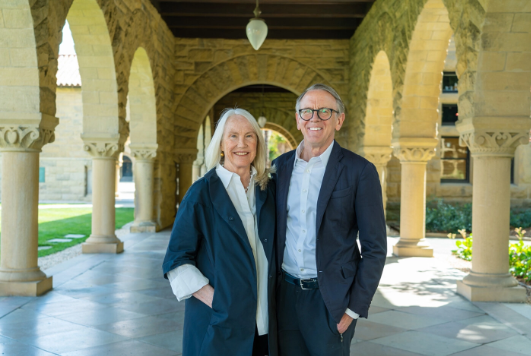John Doerr, Chairman of top Silicon Valley venture capital firm Kleiner Perkins, has donated over $1.1 billion to launch the Stanford Doerr School of Sustainability this fall. This will be Stanford’s first new school in 70 years.
The $1.1 billion gift from John and his wife Ann Doerr [photo above (credit: Edward Caldwell)] is the largest in the university’s history. The commitment, together with gifts from other generous donors, will extend the university’s scholarship and dramatically amplify its impact in tackling the urgent climate and sustainability challenges facing all people. Arun Majumdar has been appointed as the school’s inaugural dean.
The combined gifts, totaling $1.69 billion, will shepherd the creation of a new kind of school focused on cultivating deep knowledge and high-impact solutions to pressing planetary challenges. The school will have academic departments that advance subject understanding, interdisciplinary institutes that innovate across fields, and an accelerator focused on developing near-term policy and technology solutions. New faculty, new facilities, and a new institute will round out the school, bringing exceptional breadth and scale to the university’s work in addressing the future of the planet.
“These gifts will help Stanford bring its full effort to bear on solving the most complex problems in climate and sustainability, and on training the next generation of students who are eager and driven to address these challenges,” said Stanford President Marc Tessier-Lavigne. “We have designed a school for the future combining knowledge generation and impact, building on the strong foundation established through Stanford’s history of scholarship in Stanford Earth and our other schools and interdisciplinary institutes. We are deeply grateful to John and Ann for partnering with us to realize the school’s mission, as well as to the other generous lead donors who are leveraging their resources to help us create a more livable future.”
“Stanford is making a bold, actionable, and enduring commitment to tackle humanity’s greatest challenge, and we have deep conviction in its ambition and abilities,” said John and Ann Doerr. “We believe the Stanford Doerr School of Sustainability will be a model for the interdisciplinary collaboration required to solve this existential challenge – and set a new standard for scholarship in the 21st century. Today’s real and pressing challenges – not least, solving our climate crisis – require that knowledge be channeled toward the building of practical, implementable solutions. With a deep track record in groundbreaking scholarship and impact, and a critical mass of subject experts and innovators, Stanford is perfectly positioned to make a measurable difference in climate and sustainability challenges. This is the decisive decade, and we must act with full speed and scale.”
Additional philanthropic investments have been made by Jerry Yang, ’90, MS ’90, and Akiko Yamazaki, ’90; David, MS ’90, and Angela Filo, ’93; and other donors.
A distinctive approach
The new school has been designed to power excellence in eight areas of scholarship that, together, are crucial for advancing the long-term prosperity of the planet: climate change, Earth and planetary sciences, energy technology, sustainable cities, the natural environment, food and water security, human society and behavior, and human health and the environment.
Built for impact, the school will have a distinctive three-part structure that includes rigorous academic departments, interdisciplinary institutes, and an accelerator for technology and policy solutions.
- The academic departments will launch with about 90 existing faculty from Stanford and add an additional 60 faculty over 10 years to provide strength and breadth across all eight areas of scholarship. Existing faculty will include those currently in the School of Earth, Energy, and Environmental Sciences (Stanford Earth), who will transition to the new school, as well as faculty from other schools. Early faculty hires will focus on energy, climate science, and sustainable development and environmental justice.
- The interdisciplinary institutes bridge areas of scholarship across the university in service of knowledge acquisition and solutions development. The existing Stanford Woods Institute for the Environment and the Precourt Institute for Energy will become part of the school, joined by a new Institute for Sustainable Societies that adds critical new attention to issues of institutional and economic infrastructure, and the politics of transitioning to more sustainable ways of life.
- The new Sustainability Accelerator will drive policy and technology solutions. It will help advance high-potential technologies by providing laboratories, tools, and domain expertise to help researchers refine and scale prototypes. The accelerator will also support interdisciplinary policy design and engagement with external stakeholders. Competitive grants given by the accelerator will help develop sustainability technologies, policies, and innovations, and emphasize measurable impacts through partnership with the external community, connecting directly to needs in government, industry, and other outside entities.
The school will also provide curriculum, research, training, and project-funding opportunities for students across campus, regardless of area of study. In addition, the new school will collaborate closely with the university’s leading professional schools to generate essential insights and solutions that can be rapidly deployed to mitigate and better respond to climate and sustainability challenges. Additional programs, including professional education, will help equip professionals to advance sustainable solutions in real-world contexts.
The choice of the word “Sustainability” in the school’s name signals the urgent need for scholarship and new, high-impact solutions to foster a sustainable future. The school will focus on three broad areas: Earth, Climate and Society. Its creation reflects the Stanford community’s deep ambition to lead in this domain, building on the university’s decades of foundational work. Hundreds of people in the Stanford community contributed ideas, participated in town halls, worked on committees, and responded to surveys that led to the creation of this school.
The people and programs in the new school will be brought together in a new Sustainability Commons, located on the west side of campus. The Commons will be anchored by two new flagship buildings that will follow Stanford’s history of creating sustainable, LEED Platinum certified buildings. The Commons will also include the existing Green Earth Sciences Research Building and the Jerry Yang and Akiko Yamazaki Environment and Energy Building (Y2E2). A promenade will connect the academic buildings, rooftop garden, and multiple outdoor gathering spaces.
The school will be led by inaugural dean Arun Majumdar, the Jay Precourt Professor, professor of mechanical engineering, senior fellow and former co-director of the Precourt Institute for Energy, and a senior fellow at the Hoover Institution, where he co-chairs the George Shultz Energy and Climate Task Force. Majumdar’s career has spanned academic research and experience in industry, national laboratories, and government, where he led efforts implementing energy technology initiatives that included being founding director of the Advanced Research Projects Agency – Energy (ARPA-E). Majumdar currently serves as chair of the advisory board to the U.S. Secretary of Energy.



